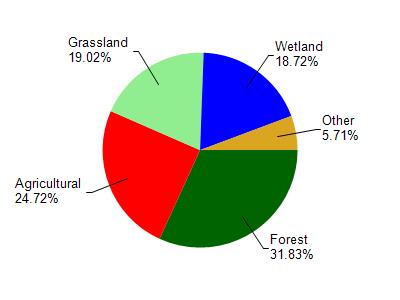Polk
No
No
Yes
Fish and Aquatic Life
Overview
Magnor Lake T33N, R15W, Sec. 22, 27 Surface Acres = 223.7, S.D.F. = 1.29, Maximum Depth = 15 ft., M.P.A. = 21 Has a navigable inlet channel from Barba Lake and an intermittent inlet stream to Nepadoggen Creek. Fish present in the lake include northern pike, walleyes, largemouth bass, bluegills, black crappies, perch, pumpkinseed and bullheads. There are no public lands or access roads present. Two resorts, one boat livery, and 22 cottages are located here at present, developing 60% of the take shore. Fifty-seven acres of marsh wetlands adjoin the take. Mallards and bluewing teal nest here.
Date
Author Aquatic Biologist
Historical Description
This 231 acre lake has a navigable channel to Barbo Lake and an intermittent outlet to
Nepadoggen Creek. Signs of excess fertility are evident on this lake and applications for
chemical treatment of weeds and algae have been routine for years. A Lakes Planning Grant to
study the level of this fertility and document the source(s) should be a priority for this lake.
The recruitment of a self-help volunteer would be a good start towards long range management
plans for Magnor Lake.
Date 1992
Author Surface Water Inventory Of Wisconsin
Impaired Waters
Magnor Lake (Richardson, WBIC 2624600) was placed on the impaired waters list for total phosphorus in 2010. The 2018 assessments showed continued impairment by phosphorus; new total phosphorus and chlorophyll-a sample data exceeded the 2018 WisCALM listing thresholds for the Recreation use and Fish and Aquatic Life use. Based on the most updated information, no change in the existing impaired waters listing was needed.
Date 2017
Author Ashley Beranek
Impaired Waters
Magnor Lake (Richardson) was placed on the impaired waters list for total phosphorus in 2010. The 2016 assessments showed continued impairment by phosphorus; total phosphorus sample data overwhelmingly exceed 2016 WisCALM listing thresholds for the Recreation use, exceeded Fish and Aquatic Life use, and chlorophyll data exceeded REC and FAL thresholds. Based on the most updated information, no change in existing impaired waters listing is needed.
Date 2015
Author Aaron Larson
Condition
Wisconsin has over 84,000 miles of streams, 15,000 lakes and milllions of acres of wetlands. Assessing the condition of this vast amount of water is challenging. The state's water monitoring program uses a media-based, cross-program approach to analyze water condition. An updated monitoring strategy (2015-2020) is now available. Compliance with Clean Water Act fishable, swimmable standards are located in the Executive Summary of Water Condition in 2018. See also the 'monitoring and projects' tab.
Reports
Recommendations
Best Management Practices, Implement
Partnering with property owners, the applicant is sponsoring a grant to implement water quality and habitat best practices from Wisconsin's Healthy Lakes Implementation Plan. Best practices, including fish sticks, 350 sq. ft. native plantings, diversions, rock infiltration, and/or rain gardens, will be designed and installed according to the Healthy Lakes fact sheets, technical guidance and grant application.
Management Goals
Wisconsin's Water Quality Standards provide qualitative and quantitative goals for waters that are protective of Fishable, Swimmable conditions [Learn more]. Waters that do not meet water quality standards are considered impaired and restoration actions are planned and carried out until the water is once again fishable and swimmable
Management goals can include creation or implementation of a Total Maximum Daily Load analysis, a Nine Key Element Plan, or other restoration work, education and outreach and more. If specific recommendations exist for this water, they will be displayed below online.
Monitoring
Monitoring the condition of a river, stream, or lake includes gathering physical, chemical, biological, and habitat data. Comprehensive studies often gather all these parameters in great detail, while lighter assessment events will involve sampling physical, chemical and biological data such as macroinvertebrates. Aquatic macroinvertebrates and fish communities integrate watershed or catchment condition, providing great insight into overall ecosystem health. Chemical and habitat parameters tell researchers more about human induced problems including contaminated runoff, point source dischargers, or habitat issues that foster or limit the potential of aquatic communities to thrive in a given area. Wisconsin's Water Monitoring Strategy was recenty updated.
Grants and Management Projects
Monitoring Projects
| WBIC | Official Waterbody Name | Station ID | Station Name | Earliest Fieldwork Date | Latest Fieldwork Date | View Station | View Data |
|---|
| 2624500 | Nepadoggen Creek | 493195 | Magnor Lake inlet (Nepadoggen Cr) from Barbo Lk | 6/13/2001 | 9/9/2019 | Map | Data |
| 2624500 | Nepadoggen Creek | 493196 | Nepadoggen Creek at Magnor Lk Outlet | 6/13/2001 | 9/9/2019 | Map | Data |
| 2624600 | Magnor Lake | 493197 | Magnor Lake - Un North Shore Trib To Magnor Lk | 6/13/2001 | 6/24/2002 | Map | Data |
| 2624700 | Unnamed | 493194 | Un Ditch - Magnor Lk Inlet From Mud Lk | 6/13/2001 | 9/9/2019 | Map | Data |
| 2624600 | Magnor Lake | 493166 | Magnor Lake - Deep Hole | 8/19/2000 | 8/25/2025 | Map | Data |
| 2624600 | Magnor Lake | 10018336 | Magnor Lake -- Access | 6/18/2005 | 8/16/2024 | Map | Data |
| 2624600 | Magnor Lake | 10004789 | Magnor Lake | 9/19/1994 | 6/12/2025 | Map | Data |
|

Watershed Characteristics
Magnor Lake is located in the Beaver Brook watershed which is 64.82 mi². Land use in the watershed is primarily forest (31.80%), agricultural (24.70%) and a mix of grassland (19%) and other uses (24.40%). This watershed has 75.34 stream miles, 1,801.18 lake acres and 5,965.27 wetland acres.
Nonpoint Source Characteristics
This watershed is ranked High for runoff impacts on streams, Medium for runoff impacts on lakes and Medium for runoff impacts on groundwater and therefore has an overall rank of Medium. This value can be used in ranking the watershed or individual waterbodies for grant funding under state and county programs.This water is ranked High Lake for individual Lakes based on runoff problems and the likelihood of success from project implementation.